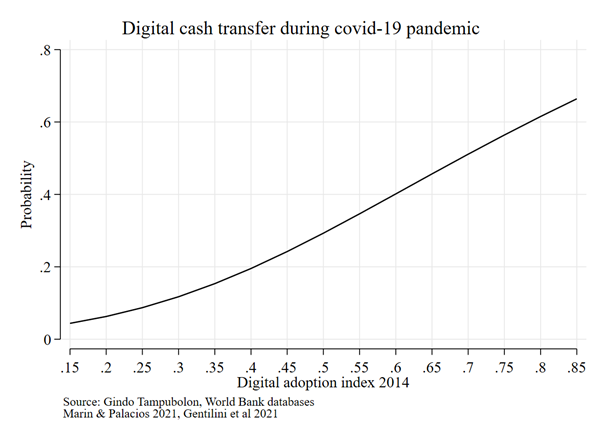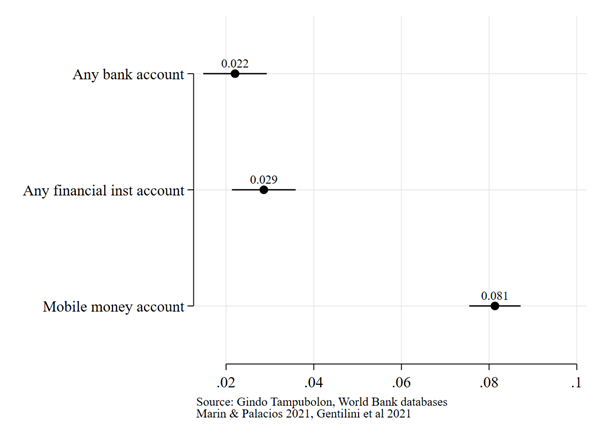The toll of the Covid-19 pandemic is still being counted. Meanwhile, new variants continue to threaten because the reservoir of people infected is still large enough for some random mutations to take hold and spread. Excess deaths, a global measure, were estimated by the WHO to be around 14.9 million in 2020-2021.
With all this immense suffering, is there a ray of hope? After all, governments supported family finances, delivered through digital and other means. With deepening financial inclusion (more families owning bank accounts or formal institutions), there are benefits to share. Account holders can smooth consumption and manage risks, banks can arbitrage between savers and inventors, governments can expect increased investment in the economy and better information on the funds circulating, useful for macroeconomic management.
If the outpouring of governments’ responses through digital transfer programmes improves financial inclusion, all is not lost. Examples of these programs have been curated by various groups including the World Bank. I used their database to mark whether the country has any digital transfer program (Gentilini 2022, Gentilini et al 2021, Marin & Palacios 2021) then collated the last three global financial inclusion surveys, the Global Findex, 2014, 2017 and 2021. (I wrote about these surveys before.) There were 146 countries and 414,945 adults aged ≥15 analysed.
Impact
To estimate the digital transfer impact, one can apply a difference in difference estimator, using the available information before and after the pandemic started in 2020. The estimator assumes parallel trends in financial inclusion: countries with and without such transfer moved side-by-side in the past 7 years. Surely, they did not. So I applied a doubly robust version, balancing the trends with information on society’s readiness for such digital transfer programmes (digital adoption index in 2014) which accompanies the World Development Report 2016. Three outcomes are important: account in banks, in any formal financial institution and as mobile money (all binaries).
Digital readiness in 2014 and excess death in 2020-2021
Countries were visited by this pandemic at different digital readiness as shown by the span of digital adoption index in 2014. But initial digital readiness relates to lower excess death later in the pandemic, once readiness passes the median (Figure 1). Beyond the median, excess death follows a steeper decline. The pandemic has witnessed governments and society deliver transfers and various supports using digital technology, all this shows in excess deaths.
Among the survivors: financial inclusion in the pandemic’s wake
Because transfer programmes were delivered through digital means in some countries but not others, what impact do they have in other matters such as financial inclusion? I first check whether countries’ readiness indeed relates to delivering support via digital transfers. The marginal plot below shows that the relation is positive, with more digital adoption in 2014 associated with higher probabilities of digital transfers in 2020.
Finally, putting all this together, the data showed an impact of digital transfer programme of 2% on owning any bank account to 8% on owning a mobile money account in the wake of the pandemic (Figure 3).
Perhaps this deepening financial inclusion is a ray of hope amidst the immense suffering. Governments, businesses and families can draw benefits from being part of a more inclusive financial system in the wake of this pandemic.
References
- Gentilini U. 2022. Cash Transfers in Pandemic Times : Evidence, Practices, and Implications from the Largest Scale Up in History. World Bank Group. http://hdl.handle.net/10986/37700
- Gentilini, U., Almenfi, A., Blomquist, J., Dale, P., De La Flor Giuffra, L., Desai, V., Fontenez, M., Galicia Rabadan, G., Lopez, V., Marin Espinosa, A., Natarajan, H., Newhouse, D., Palacios, R., Quiroz, Ana., Rodriguez Alas, C., Sabharwal, G. and Weber, M. (2021) ““Social Protection and Jobs Responses to COVID-19: A Real-Time Review of Country Measures”. World Bank, Version 15 (May 14).
- Marin G. and Palacios R. 2021. The Role of Digital in the COVID-19 Social Assistance Response. Washington, D.C. : World Bank Group.
- Tampubolon G. 2018. The Puzzle of Digital Financial Inclusion: A Generation Game? ICTs for Development blog.
- World Bank 2016. World Development Report 2016: Digital Dividends. World Bank.
Top image of a vendor during the Covid-19 pandemic in Mysuru, Karnataka, India. Photo by Syed Ali on Unsplash




